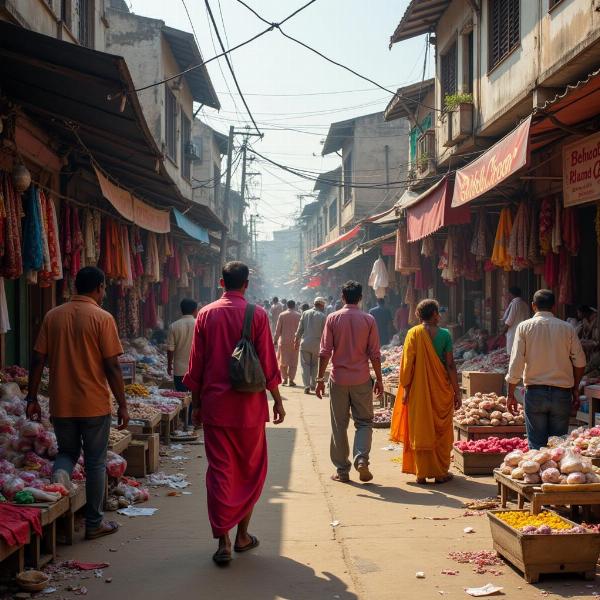Understanding the nuances of slang and colloquialisms can be tricky, especially when navigating a language as rich and diverse as Hindi. The phrase “bloody cheap” is a prime example. This guide delves into the meaning, usage, and cultural context of “bloody cheap” in Hindi, providing you with a comprehensive understanding of this commonly used expression.
Decoding “Bloody Cheap”: More Than Just a Literal Translation
While a direct translation might suggest “खूनी सस्ता” (khooni sasta), this is rarely used and often sounds unnatural in Hindi. Instead, several expressions capture the essence of “bloody cheap” depending on the context and desired emphasis. These range from simple terms like “बहुत सस्ता” (bahut sasta) meaning “very cheap” to more colorful and emphatic phrases. This guide explores these varied expressions, helping you choose the right one for any situation.
 Bargaining at a Street Market
Bargaining at a Street Market
Common Hindi Equivalents for “Bloody Cheap”
Several Hindi phrases effectively convey the meaning of “bloody cheap,” each with its own subtle connotations. Here are some of the most common ones:
- बहुत सस्ता (Bahut Sasta): This is the most straightforward and commonly used equivalent, simply meaning “very cheap.”
- सस्ते में (Saste Mein): This translates to “at a cheap price” and is often used when discussing the purchase of something.
- कौड़ियों के भाव (Kaudiyon Ke Bhav): This idiom translates to “the price of cowries” (cowries being small shells formerly used as currency). It implies something is extremely cheap, almost worthless.
- मुफ्त का माल (Muft Ka Maal): This translates to “free goods” and is used hyperbolically to describe something incredibly cheap.
- मिट्टी के मोल (Mitti Ke Mol): Meaning “the price of dirt,” this idiom highlights the extreme cheapness of something.
Cultural Context and Usage
The phrase “bloody cheap,” while common in Indian English, isn’t always appropriate in formal settings. Its usage is generally confined to informal conversations amongst friends or family. It can be used to express delight at finding a bargain, to playfully exaggerate the cheapness of something, or even to express surprise at the low price.
Navigating the Nuances: Choosing the Right Expression
Selecting the appropriate Hindi equivalent for “bloody cheap” depends heavily on the context. “Bahut sasta” is a safe bet for most situations, while more emphatic phrases like “kaudiyon ke bhav” are better suited for expressing extreme cheapness or disbelief at a low price. Understanding these nuances is crucial for effective communication.
Bloody Cheap vs. Dirt Cheap: A Subtle Difference
While both “bloody cheap” and “dirt cheap” convey extreme affordability, “bloody cheap” often carries a more playful or even slightly irreverent tone. “Dirt cheap” is generally considered more neutral.
What if you’re talking about services, not goods?
When discussing the price of services, you can still use most of the phrases mentioned above. However, you might also consider using phrases like “कम दाम में (kam daam mein)” which means “at a low price.”
Is “bloody cheap” offensive in Hindi?
While “bloody” itself can be considered mildly offensive in some contexts, when combined with “cheap,” it usually loses its offensive connotation and becomes more of an emphatic expression. However, it’s always best to be mindful of your audience and the context.
Conclusion: Mastering the Art of “Bloody Cheap” in Hindi
Understanding the nuances of “bloody cheap” and its various Hindi equivalents is crucial for anyone navigating the complexities of Indian English and Hindi. This guide provides a comprehensive overview of the meaning, usage, and cultural context of this common expression, equipping you with the tools for effective communication. By mastering these subtleties, you can confidently navigate everyday conversations and express yourself with greater precision and cultural sensitivity.
FAQ:
- What is the most common Hindi equivalent for “bloody cheap”? Bahut sasta is the most common and generally accepted equivalent.
- Is “bloody cheap” considered offensive in Hindi? While “bloody” can be offensive on its own, in this context it usually serves as an intensifier rather than a profanity. However, caution is advised depending on the audience.
- Can I use “bloody cheap” in formal settings? It is best to avoid using this phrase in formal situations, opting for more neutral alternatives like bahut sasta or kam daam mein.
- What are some other ways to express extreme cheapness in Hindi? Kaudiyon ke bhav and mitti ke mol are idioms that emphasize extreme cheapness.
- How do I choose the right Hindi equivalent for “bloody cheap”? The context of the conversation and the level of formality should guide your choice of phrase.
Meaning-Hindi.in is your one-stop solution for all your Hindi translation needs. We offer a wide range of services, including business and commercial document translation, certified and legal document translation, technical and user manual translation, website and localization services, educational and academic document translation, express translation, and specialized translation services. We pride ourselves on delivering accurate, culturally sensitive translations that meet the highest quality standards. Contact us today at [email protected] or +91 11-4502-7584 to learn more about how Meaning-Hindi.in can help you bridge the language gap.